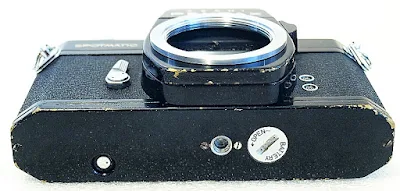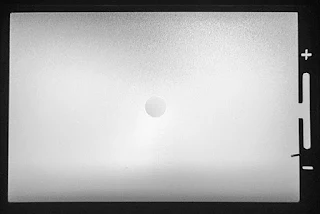The Asahi Pentax Spotmatic SP, an all-mechanical manual focus M-42 screw-mount 35mm SLR film camera, manufactured by Pentax between 1964 and 1976, was the first SLR camera to offer TTL (through-the-lens) metering. The camera was the first model of the Pentax Spotmatic series which includes a pair of meterless models, SP500 and SP1000, and updates Spotmatic II/Spotmatic IIa (SPII), Electro-Spotmatic (1971), ES, ESII, and Spotmatic F (1973). The Spotmatic IIa was made exclusively for the American market.
Operationally, the simplistic and utilitarian (by today's standard) Spotmatic SP is fitted with a horizontal-travel cloth focal-plane shutter with a speed range from 1 to 1/1000 seconds, and Bulb, with flash synchronization at 1/60 seconds. The camera accepts film ISO speeds from 20 to 1600, has a variable self-timer with a 5 to 13-second delay, and is devoid of a hot shoe, mirror lock-up, depth of field, or exposure compensation features.
Metering on the Spotmatic SP is powered by a 1.35-volt (now banned) mercury battery. The SLR is compatible with most Auto/Manual M42 screw mount lenses. With the lens set to Auto, focusing and framing can be done in a bright frame or at full aperture, while metering is stop-down, meaning that the lens aperture opening needs to be stopped down or closed to correctly measure the light before the shutter is released.
Introduction to the Pentax Spotmatic SP and SP 1000, Video 1 of 2
This video introduces the Pentax Spotmatic SP and SP 1000 interchangeable-lens SLR cameras. This video shows you the cameras features and basic operation. To...
Basic Camera Features
Over its long production run, the only additions made to the Spotmatic series, other than the hot-shoe added to the Spotmatic II/IIa and later models, were an improved lens mount and a new switch for the open-aperture meter.Pentax 35mm SLR film cameras are also known to have been engineered with a simple bridge circuit that allows for the use of higher voltage silver oxide batteries which will still give you accurate meter readings, a bonus to get you to go for the "Buy Now" button immediately
The Spotmatic SP model is available in both black and chrome.
On the front of the camera is the simple and straightforward screw-mount lens housing with the push-up metering switch located on the upper part of the right vertical. Towards the lower part of the front right is the vertical arrangement of the LP and X flash terminals, while to the right of the lens mount housing is the self-timer rocker switch.
Self-timer activation is done after the shutter is cocked, i.e. after the film has been advanced to the next shooting frame. Turn the rocker lever anti-clockwise to the desired time range (5 to 13 seconds) and start the timer countdown by pressing the small ball button which is otherwise hidden behind the self-timer lever flap.
On the top plane, a simple layout with the film rewind crank integrated with the film type index dial which is also the pull-up latch lock for the film back. Towards the middle is a simple and plain pentaprism hump and to the right a cluster of components consisting of the shutter speed dial with a pull-up and turn ISO setting dial, the shutter release button, a small shutter-cocked window indicator, and the film forward crank integrated with the film frame counter.
The hinged film back is plain and simple with no adornments, and on the back of the pentaprism hump, along the top plane of the film back, is the viewfinder eyepiece. The film back is fixed and is not interchangeable.
On the bottom plane of the camera are the tripod socket, the film rewind release button, and the battery chamber cover.
The film box is a straightforward quick-load system with the film canister chamber, the picture frame window, sprocket gear, and a multi-slot take-up spool. The film is loaded by pulling the tab end of the film roll across the back and slotted into the take-up spool before the film is wound firm to ensure the sprocket tooth is properly engaged before the film back is closed.
Once the back is closed use the two-blank shots technique to properly forward the start of the unexposed film roll to Frame 1.
Film Rewinding and Unloading
Film rewinding and unloading are by a sequence of first pressing the film rewind release button located on the bottom plate of the camera, next by extending the crank tab of the film rewind crank out and turning it clockwise to spool the exposed film back into the film canister.Open the film back and remove the film canister once the rewind process is complete, once the tension that you feel while rewinding the film is released.
Viewfinder Readout
Set the needle towards the middle of the opening for the correct exposure before releasing the shutter.
Setting the needle slightly above the center to lighten images in backlighted shots or doing the opposite to lighten up darkened objects is a way of getting by issues of exposure compensation on the Spotmatic SP.
Stop-Down Metering
Stop-down metering is activated by the switch located on the side of the housing mount, which is disengaged once the shutter is released.Battery
The Spotmatic SP was originally designed to use the smaller 1.35v PX400 cells, which are now banned. I am using instead, the mite-sized 1.5-volt AG3/392A button cell as a replacement and all is going great.Camera Body Weight
The Pentax Spotmatic SP camera's body weight is 621 grams without a battery.The Easy Steps
With its fully manual stop-down metering one can see immediately the effect of varying the shutter speed and lens aperture opening of the exposure (Shutter Speed, Lens Aperture, Film ISP Speed) triangle, as well as the accelerated knowledge of the visuals of DoF (Depth of Field) and other within the learning curriculum.
Set the camera up by coupling the Spotmatic SP with an Auto/Manual M42-mount Super Takumar lens and you are all set to go.
You will begin to notice that the depth of field of subjects in focus is naturally quite shallow. You can easily pick on the objects that you want to pop out while letting the rest of the fore- and background remain blurry.
Once you are satisfied with the frame and focus, set the exposure meter to ON, and next, adjust the aperture opening of the lens to a smaller value until the exposure needle pointer is centered on the exposure display bar. Press the shutter release and you are off to a good start.
Shooting with fixed a shutter-speed option, while adjusting the lens aperture for the correct exposure setting is the way to do it in a shutter-priority way, and in reverse, shooting with a fixed-aperture opening while varying the shutter speed setting is doing it in the aperture-priority way.
Model Variation
If you are interested in a lower-priced variation of the all-mechanical fully manual camera, there is the Spotmatic SP500, with a top shutter speed of 1/500 second, and the Spotmatic SP1000 which has a top speed of 1/1000 second, which was built without the light meter.To opt for a version that offers open-aperture metering, mounted with updated Super-Multi-Coated (S-M-C) Takumar lenses with an aperture-position linkage to the camera, look up the Spotmatic SP F.
























No comments:
Post a Comment